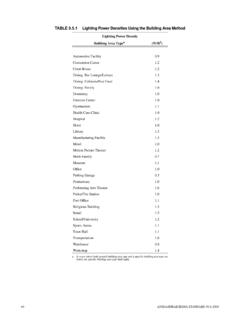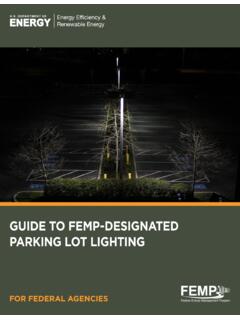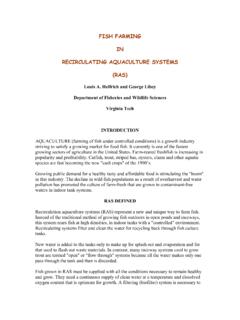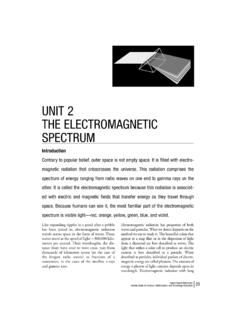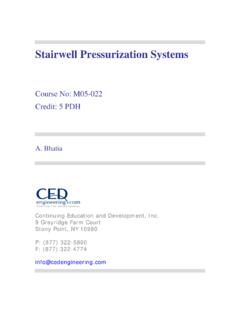Transcription of Requirements for Lighting Levels
1 Requirements for Lighting Levels Eric E. Richman Pacific Northwest National Laboratory Lighting systems are most effectively designed based on the light Levels or illuminance required by the tasks performed within each building space. The accepted authority for appropriate illuminance values is the Illuminating Engineering Society of North America (IESNA). The IESNA publishes a comprehensive Handbook along with supplemental Recommended Practice Guides that provide tables of appropriate illuminance data. Many designed systems do not specifically follow the current guidelines. Office spaces are often over-lit as a result of the Lighting being designed and installed prior to 1985, or rules of thumb based on out of date Lighting technologies.
2 These older Lighting systems are designed to accommodate paper-based reading tasks at light Levels of 750-1000 lux. Current office operations primarily involve computer based and higher quality printed tasks such that overhead Lighting can be reduced to between 300 and 500 lux. Another consideration in Lighting systems design are the Lighting power Density limits imposed by energy codes such as those found in Section 9 of the ASHRAE/IESNA Standard 2007. These limits are based on the latest illuminance recommendations form IESNA and are designed to allow for quality Lighting design using reasonably efficient Lighting equipment. The limits are provided for whole buildings or individual space types as Lighting power densities (LPD) expressed in watts per square foot (W/ft2).
3 The LPDs in Standard are based on standard T8 lamps and electronic ballasts. Even more efficient high performance lamp and ballast combinations are available that can be used to design Lighting systems that consume less than the limit imposed by these standards. Table 1 lists current illuminance recommendations (lux) for Lighting Levels in typical Army facilities. The table also includes a typical measurement height. This is the height off of the floor at which the average measured illuminance should be at least as high as the recommended illuminance value. Note that this is an average, so multiple measurements in a space should be averages at this height for comparison with the recommendations.
4 Energy and Water Conservation Design Requirements for SRM Projects 2 Table 1. Examples of design illumination Levels for selected Army buildings and spaces (IESNA 9th Edition Handbook, 200, Illuminating Engineering Society of North America.). Building Type Space Type Maintained Average Illuminance at working level (lux) Measurement (working) Height (1 meter = feet) Barracks/Dormitories Bedrooms 300 at 0 m Laundry rooms 300 at 1 m Educational Buildings Play room, nursery, classroom 400 at 0 m Lecture hall 400 at m Computer practice rooms (menu driven)
5 30 at m Office buildings Single offices 400 at m Open plan offices 400 at m Conference rooms 300 at m Educational buildings Classrooms 300 at m Classrooms for adult education 400 at m Lecture hall 400 at m Hospitals General ward Lighting 300 at m Simple examination 500 at m Examination and treatment 1000 at m Hotels and restaurants Self-service restaurant, dining room 100 at m Kitchen 500 at m Buffet 100 at m Sport facilities Sports halls 300 at 0 m Wholesale and retail sales Sales area 500 at m Till area 500 at m Circulation areas Corridor 50 at 0 m Stairs 50 at 0 m Restrooms 300 at 0 m Cloakrooms, washrooms, bathrooms.
6 Toilets 300 at m Industrial Metal working/ welding 300 at 1 m Simple Assembly Difficult Assembly Exacting Assembly 300 1,000 3,000-10,000 at 1 m Central Plant Boiler house Machine Halls Side rooms, pump rooms, condenser rooms etc. Control rooms 50 300 300 500 at 0 m Vehicle Construction/ Maintenance Body work and assembly Painting, spraying, polishing Painting, touch-up, inspection 500 1000 3,000-10,000 at 1 m Wood working and processing Saw frame Work at joiner s bench, assembly Polishing, painting, fancy joinery Work on wood working machines turning, fluting, dressing, rebating, grooving, cutting, sawing, sinking 300 300 1000 500 at 1 m
